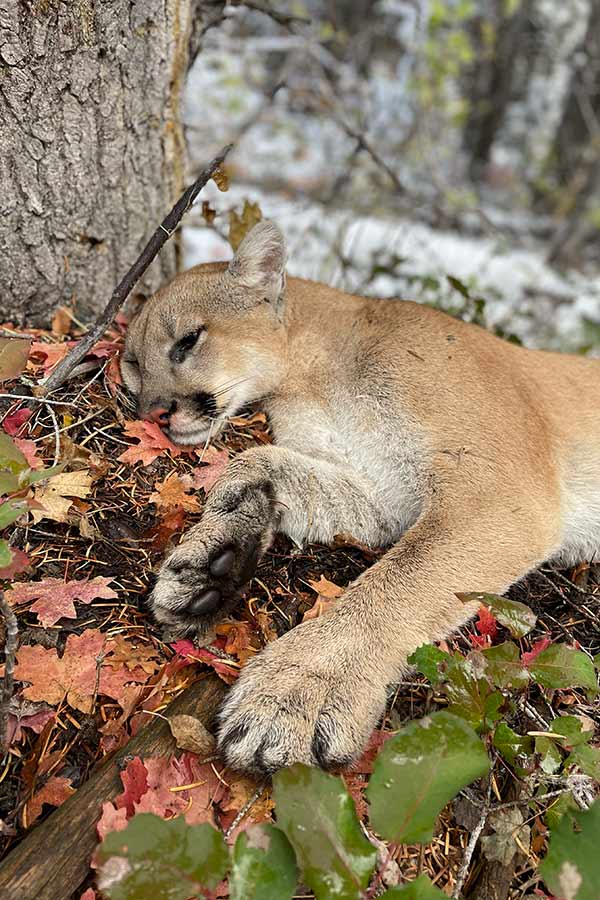Tips to keep you safe if you encounter a cougar in Utah
Salt Lake City — Cougars, mountain lions, pumas: They have several different names, but these elusive predators can be found throughout Utah. While cougar attacks are quite rare in the U.S., there is always the chance you may see a cougar on your doorbell camera footage or while you are out hiking this summer. If you do happen to encounter a cougar, there are a few simple steps you can take to keep yourself safe.
Cougars can be found throughout Utah, usually in the foothill and canyon areas, but also sometimes down in the valleys — especially during the winter months when they follow food-seeking deer to lower elevations. Trends of population data indicate that cougar numbers in Utah have been growing steadily for the last few years.
The main prey of cougars is deer, so they can be found wherever deer are. They will also eat elk, pronghorn, small mammals and sometimes birds. After making a kill, a cougar will often hide or cache the carcass by covering it with soil, leaves or snow, saving it to feed on later.
While many wildlife species are heavily impacted by drought, drought conditions typically don't have a substantial short-term impact on cougars. With declines in deer numbers from drought conditions, there could be a longer-term decline in cougar numbers; however, in areas with alternative prey sources, cougars may still have enough to eat and there may not be any decline in cougar numbers. If severe drought conditions cause prey to leave an area, the cougars will likely follow and leave the area, as well. It is possible that deer seeking water sources in towns and cities may draw cougars to those areas this summer as well.
"People are the most likely to encounter cougars in areas frequented by mule deer and during the early morning and at dusk, when cougars are most likely to be hunting," Utah Division of WIldlife Resources Game Mammals Coordinator Darren DeBloois said.
Here are some tips to help prevent conflicts with cougars:
- Do not hike or jog alone.
- Maintain awareness in cougar country while hiking or jogging and avoid using headphones that block out your surroundings.
- Travel in groups and keep everyone together, including children and dogs.
- Make noise while hiking to alert cougars of your presence.
- Leave the area if you find a dead animal, especially deer or elk, since it could be a cougar kill.
- If you live in an area near deer habitat, do not leave children outside unattended, especially at dawn and dusk.
- As a deterrent, install outside and motion-sensitive lighting around your property.
- Trim vegetation and remove wood piles to reduce hiding places for wildlife.
- Bring pets and livestock inside at night or secure them in a barn or kennel with a top.
In the rare event that you do happen to encounter a cougar, here are some tips to help keep you safe:
- Never run from a cougar, since that could trigger the cougar's instincts to chase.
- Maintain eye contact.
- Pick up children and pets or keep them very close.
- Stand up tall.
- Do not crouch or squat.
- Make yourself look bigger by raising and waving your arms or jacket above your head.
- Talk firmly in a loud voice, back away slowly and leave the area.
- Fight back if you are attacked! Protect your head and neck.
- If you are aggressive enough, the cougar will probably flee.
"Typically, a cougar that is trying to prey on something will sneak up and ambush them," DeBloois said. "When a cougar lunges or bluffs a charge at someone, they are typically just trying to drive them out of the area because they have kittens or a kill nearby that they are trying to protect."
There has been an increase in cougar sightings over the last few years, due to an increase in cougar numbers, an increase in doorbell and security cameras, and an increase in the number of people moving into cougar and deer habitat areas.
You should report a cougar sighting if:
- It has killed something in a neighborhood or yard.
- It exhibits aggressive behavior.
- It appears several times on your security cameras.
If you capture footage of a cougar on security cameras one time or see one from a distance in foothill areas, you do not need to report it. One-time sightings of cougars are typically when the animal is moving through an area, and it has often left by the time DWR biologists and conservation officers can respond.
For more safety tips, visit the Wild Aware Utah website.


















